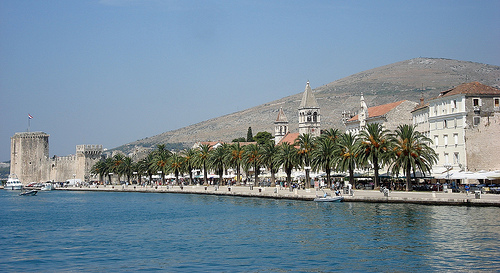

Kamerlengo Castle (Gradina Kamerlengo), also known as Kamerlengo Fortress, is a prominent 15th-century Venetian stronghold located in the historic town of Trogir, Croatia. Situated at the southwest corner of Trogir's UNESCO-listed Old Town island, it overlooks the Adriatic Sea and the channel separating Trogir from Čiovo Island. The name "Kamerlengo" derives from the Venetian term for a chamberlain or administrator, reflecting its historical role in managing the city's defenses and finances. Today, it serves as a popular tourist attraction, offering panoramic views, cultural events, and a glimpse into medieval military architecture. While primarily a defensive structure, it has been repurposed for open-air concerts, film screenings, and festivals, blending history with modern entertainment.
The site's defensive importance predates the current
structure, with a polygonal tower erected in the late 14th century
during the period of Hungarian-Croatian rule to protect Trogir from
seaward threats. In 1420, the Venetian Republic conquered Trogir,
incorporating it into their maritime empire, and promptly expanded the
fortifications. The castle was constructed between 1420 and 1437 under
the orders of the Venetian authorities, designed by architect Marin
Radoj (or Marino Radoje), who served as the local kamerlengo. This
expansion transformed the earlier tower into a full-fledged fortress,
connected to the city walls and St. Mark's Tower to form a comprehensive
defensive system.
During Venetian rule (1420-1797), Kamerlengo
functioned not only as a military garrison but also as an administrative
center for collecting taxes and overseeing trade, reflecting Venice's
control over Dalmatian ports. It housed soldiers, stored weapons, and
served as a prison. In the 19th century, under Austrian Habsburg rule,
it lost its military significance and fell into disrepair. The 20th
century saw restoration efforts, particularly after World War II, when
it was adapted for cultural use. Notably, during the 1990s Yugoslav
Wars, Trogir avoided major damage, preserving the castle. Recent
updates, as of 2024, include maintenance to its trapezoidal layout and
turrets, ensuring its role as a heritage site within Trogir's
Romanesque, Gothic, Renaissance, and Baroque ensemble.
Kamerlengo Castle exemplifies Venetian military
architecture, characterized by its robust stone construction using local
limestone, designed to withstand sieges and naval attacks. The fortress
has a trapezoidal ground plan, approximately 60 meters (197 feet) long
and 40 meters (131 feet) wide, with thick walls up to 2 meters (6.5
feet) thick. Its most striking feature is the large polygonal tower at
the seaward corner, dating to the 14th century, which was integrated
into the Venetian design and rises about 15 meters (49 feet) high with
crenellated battlements for archers.
The other three corners feature
cylindrical turrets, added during the 15th-century expansion, each with
slit windows for defense. The entrance is via a arched gateway on the
landward side, once protected by a drawbridge over a moat (now filled).
Inside, the courtyard is an open space with minimal internal structures,
as the castle was primarily defensive rather than
residential—essentially an "empty shell" with remnants of barracks and
storage rooms. Wooden walkways and stairs allow access to the upper
ramparts, which were connected to Trogir's city walls and the adjacent
St. Mark's Tower, forming a unified fortification. Architectural
influences blend Gothic elements (pointed arches) with Renaissance
practicality, emphasizing functionality over ornamentation.
One of the castle's highlights is the climbable ramparts and towers, providing 360-degree views of Trogir's red-tiled rooftops, the Cathedral of St. Lawrence, the Adriatic Sea, and distant islands—ideal for photography and sunset watching. The polygonal tower houses a small exhibition space with historical artifacts, such as Venetian coats of arms and cannon replicas, evoking its military past. The open courtyard often hosts events like the Trogir Summer Festival, with concerts, theater performances, and medieval reenactments under the stars. A unique feature is the preserved defensive slits and embrasures, demonstrating Venetian engineering for crossbow and early cannon use. The castle's integration with Trogir's fortifications, including the nearby Vitturi Tower, underscores its role in the town's medieval defense network.
Kamerlengo Castle is open daily from 9:00 AM to 8:00 PM in summer (June-September), with reduced hours in shoulder seasons (10:00 AM to 6:00 PM) and potential closures in winter—check locally for updates. Admission is approximately €5 for adults, €3 for children and students, with free entry for under-7s. Tickets are purchased at the entrance; no advance booking is needed, though guided tours (around €10-15) can be arranged through Trogir's tourist office for deeper historical insights. The site is accessible on foot from Trogir's center (5-minute walk from the main bridge), with nearby parking available. Accessibility is limited due to uneven stone paths and stairs—no elevators, making it challenging for those with mobility issues. Photography is encouraged, and the castle is family-friendly, though supervision is advised on the ramparts. Reviews highlight the stunning views and affordable entry, averaging 4.5/5, with some noting crowds in peak season. Combine visits with St. Mark's Tower or a Trogir walking tour for a full experience.